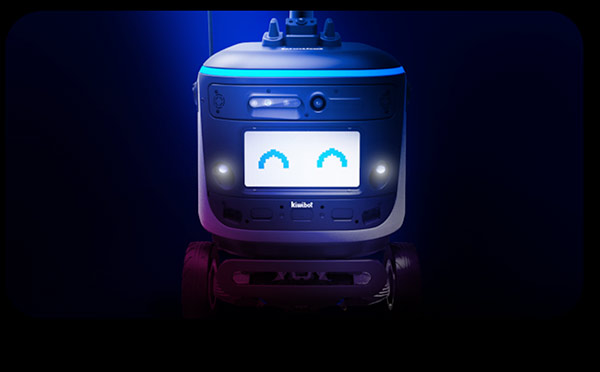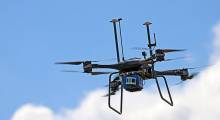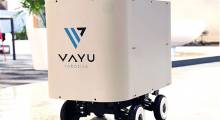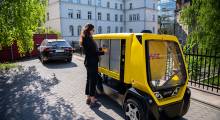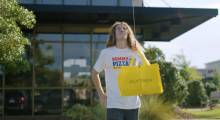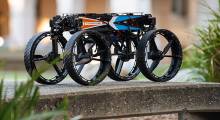Kiwibot today said that it has launched Kiwibot 4.0, a semi-autonomous mobile robot for food deliveries. The Berkeley, Calif.-based company made its announcement with a YouTube video complete with an anime-style introduction, musical clips, and a lightsaber battle (see below). Students at the University of California, Berkeley, have given the robot user ratings of up to 4.6 and have even dressed up as Kiwibots for Halloween, said Arya Anand, head of user research at Kiwibot.
More seriously, Kiwibot also announced partnerships with Segway, Knight Foundation, Chick-fil-A, and Shopify. The company said it has built more than 400 Kiwibots and completed more than 150,000 food deliveries to date. Kiwibot is dedicated to developing a safer, more economical, and more environmentally sustainable way to deliver goods, said Felipe Chávez Cortés, co-founder and CEO of Kiwibot.
Kiwibot features
Kiwibot's next-generation mobile robot was designed from the ground up, with new sensors, artificial intelligence, and other modular features for human-machine interaction. “It was a long process, from defining requirements to production,” said Natalia Pinilla, head of hardware at Kiwibot. She said the robot was tested in Taipei, Taiwan, before being rolled out in Columbia and California.
Kiwibot 4.0's sensors can perceive people, traffic lights, and vehicles in its environment and make decisions in path planning and obstacle avoidance. A flag and lights are designed to make the robot safer around pedestrians and cars.
The upgraded Level 3 autonomous devices are also supported remotely by trained human supervisors to cross streets and stop immediately to ensure safe operations, stated Kiwibot.
“Our foremost priorities are the safety of people, the environment, and goods,” said John Betancourt, head of AI and robotics at Kiwibot. “At the [delivery] site, the robot decides whether to turn or wait for the customer.”
The robot's casing includes security measures, and it can withstand different weather conditions. It can also support branding, Chávez Cortés said. In addition, Kiwibot 4.0 can interact with people through a speakers and screen with blinking eyes for expressions, he said.
It also has a cooling system and a bigger container than its predecessors for contactless delivery, said Pinilla.
“We're designing not only technological enchancement, but also fo operational excellence,” said Diego Varela, chief operating officer at Kiwibot. The robot includes tools for integration with any retail partner or campus within a matter of weeks, he said.
Partnerships and deployment
Segway has a manufacturing partnership with Kiwibot to improve the robot's capabilities during its pilot phase, said Tony Ho, vice president for global business development at Segway. NVIDIA provides the processing power for Kiwibot 4.0, Pinilla said.
Chick-fil-A has experienced a significant increase in delivery demand over the past year. The quick-service restaurant, as well as campus food provider Sodexo, has evaluated the effect of robots on customer experience in its partnership with Kiwibot. The company is looking for additional partners.
The delivery robots are already on college campuses and the streets of Santa Monica, Calif. By May 2021, customers can use Shopify-powered portals to use Kiwibot's service in Los Angeles, Miami, Pittsburg, Detroit, and San Jose, Calif., said Kiwibot.
Shopify customers at local businesses, college campuses, airports, or malls will be able to order food. Kiwibots will then meet them up to a mile away and provide service with a smile, said the company. The average delivery takes 30 minutes and costs $1.99, and the robot won't be expecting a tip, it added.
Community and sustainability
Through its foundation and “Kiwibot squad,” the company hopes to work closely with community organizations, small-business owners, and individuals, Anand. San Jose was the first city to be connected to the robot's application programming interface (API), with Los Angeles following, said David Rodrigues, head of business development at Kiwibot.
“Eighty perccent of deliveries in the U.S. are by cars powered by gas, and half of California has been in drought,” said Chávez Cortés. “By 2030, deliveries could increase carbon emissions by 30%.”
He added that Kiwibot saves 1,000 grams of carbon dioxide per delivery, with a goal of 10 million grams this year. Chávez Cortés said Kiwibot hopes to create the biggest robotic fleet in the world.
About the Author
Follow Robotics 24/7 on Linkedin
Article topics
Email Sign Up

